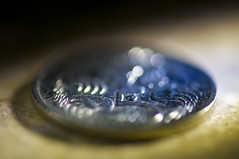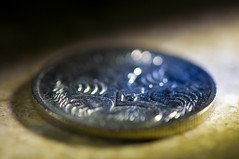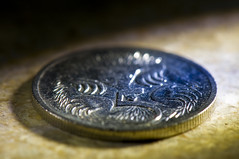Depth of field
See also Lens: Depth of field
In the abstract
Depth of field is a measure of the zone of distances (from near to far) that are within acceptable sharpness at a given aperture and focus distance. "Acceptable" sharpness is subjective and becomes more critical for larger prints or projection.
When a lens is focused on a subject at a given distance, all subjects at that distance are sharply focused. In theory, subjects that are not at the same distance are out of focus, and thus not sharp. However, since human eyes cannot distinguish very small degree of unsharpness, some subjects that are in front of and behind the sharply focused subjects may still appear to be sharp. This zone of acceptable sharpness is referred to as the depth of field. Thus, increasing the depth of field increases the perceived sharpness of an image. Using smaller apertures or larger distances increases the depth of field.
Depth of field extends further behind the plane of focus than in front and the difference increases with distance. This can be used to good effect by the so-called hyperfocal setting. For example, for a landscape photograph using a 50mm lens at f8 if, instead of focussing normally, the depth-of-field scale is used to set infinity at the f8 marking then the theoretical depth of field extends forward to 5 metres. In other words, the lens is focussed at 10 metres instead of infinity taking advantage of depth of field to bring more of the scene into focus.
Depth of field is proportional to distance from the lens optical centre to the subject, not film plane to subject. This explains why depth of field reduces dramatically when the subject is very close, since subject distance from the optical centre has reduced proportionally more than overall distance. At long distances the small difference between film plane and optical centre is insignificant.
As aperture is reduced depth of field increases, however diffraction then decreases overall sharpness. Most lenses render highest sharpness at one or two stops less than their maximum aperture, much smaller apertures usually reduce both sharpness and contrast as diffraction degrades the image.
Depth of field has nothing to do with lens construction: it is a purely geometric property. Whether zoom or prime (fixed) lens, regardless of how many elements, whether wide angle or telephoto, depth of field is the same for a given f stop and magnification at the film plane or image sensor. Depth of field is commonly thought to be related to focal length, but is actually related to magnification. Changing to a longer focal length or moving closer to the subject both have the same effect of increasing magnification and reducing depth of field.
A lens with poor resolution may appear to have greater depth of field but this is simply due to none of the picture being truly sharp. Low cost cameras with fixed focus lenses take advantage of this effect.
In practice
Most cameras above a certain level of complexity have some way for the photographer to determine the depth of field, in order to use this information in . Most standard and higher-end SLR lenses have what is known as a "Depth of Field scale" or "Depth of Field calculator," in which the focus ring and the fixed body of the lens each have a precisely calculated scale printed on them. One scale has various distances, often in both meters and feet. Due to the nature of lenses, this is normally not a linear progression, but roughly exponential, i.e., the distance between one and two meters on the scale is normally smaller than the distance between two and three meters, and so on. The second scale has a mark for the absolute point of focus (i.e., the distance at which the lens is truly, actually in sharp focus), and on either side of this mark, two marks for each f-stop (or each f-stop above, say, f/4, if the lens has a shallow depth of field). The range of distances on the first scale that fall between the marks for a given f-stop will be in acceptable focus at that f-stop.
Most film and some digital SLR's also have a way to preview the depth of field directly, by stopping down the diaphragm to the selected f-stop. This allows the photographer to see the area that is in focus exactly as the film/sensor will see it. Additionally, many rangefinders and TLR's have scales to calculate depth-of-field on the lens or focusing mechanism, but in some lower-end cameras the scale is imprecise.
|
|
|
| ||||||||
|
Effects of increasing Depth of Field | |||||||||||
Links
- "Depth of field" at Wikipediia
- Depth of field explained by Dr. Ching-Kuang Shene
- Online depth-of-field calculator from DOFMaster.com
- More online calculators for hyperfocal distance and DOF, from John Hendry
- "Depth of Field and Bokeh" by Dr. Hubert Nasse, a white paper from Carl Zeiss at Zeiss Global



